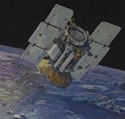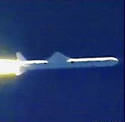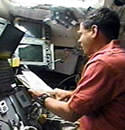
Image credit: NASA
CloudSat, a new satellite mission planned to launch in 2004, will use an advanced radar to study the properties of clouds. It will measure every aspect of the Earth’s clouds, including thickness, height, water and ice content. Using its cloud-penetrating radar, it should be able to increase the accuracy of severe storm, hurricane and flood warnings. It will also fly in orbital formation with several other weather satellites to help form a more complete picture of the Earth’s weather.
“I’ve looked at clouds from both sides now, from up and down and still somehow
It’s clouds’ illusions I recall. I really don’t know clouds at all…”
So laments Joni Mitchell’s classic song “Both Sides Now,” appropriate words as NASA prepares for a mission that should remove much of the mystery from those “rows and flows of angel hair” that so affect Earth’s weather and climate, yet are so misunderstood.
CloudSat, the most advanced radar designed to measure the properties of clouds, will provide the first global measurements of cloud thickness, height, water and ice content, and a wide range of precipitation data linked to cloud development. The Earth System Science Pathfinder Mission is expected to improve weather forecasting and advance our understanding of key climate processes during its two-year design lifetime. CloudSat is planned for launch in 2004 aboard a Boeing Delta rocket from Vandenberg Air Force Base, Calif. NASA’s Jet Propulsion Laboratory, Pasadena, Calif., manages the mission for NASA’s Earth Explorers Program Office at the Goddard Space Flight Center, Greenbelt, Md.
“Despite the fundamental role of clouds in climate and weather, there is much we do not know about them,” said CloudSat Principal Investigator Dr. Graeme Stephens of Colorado State University’s Department of Atmospheric Science, Fort Collins, Colo. “The lack of understanding of cloud feedback is widely acknowledged in the scientific community to be a major obstacle confronting credible prediction of climate change. CloudSat aims to provide observations necessary to greatly advance understanding of climate issues.”
Stephens and Co-Principal Investigator Dr. Deborah Vane of JPL discuss the necessity of CloudSat’s measurements in the current Bulletin of the American Meteorological Society. “The vertical profiles of global cloud properties provided by CloudSat will fill a critical gap in the understanding of how clouds affect climate, uncovering new knowledge about clouds and precipitation, and the connection of clouds to the large-scale motions of Earth’s atmosphere,” Vane said.
CloudSat will help researchers in numerous disciplines. It will provide better understanding of climate processes by supporting new, detailed investigations of how clouds determine Earth’s energy balance and how Earth responds to the incoming solar energy that fuels the climate system. It will improve weather prediction models by measuring cloud properties from the top of the atmosphere to Earth’s surface, filling in a gap in existing and planned space observational systems. CloudSat’s radar can penetrate thick cloud systems, providing information to increase the accuracy of severe storm, hurricane and flood warnings. CloudSat will improve water resource management by linking climate conditions such as El Nino to hydrological processes that affect drought, severe weather and water supply availability. The mission will also develop advanced technologies, including high-power radar sources, methods of radar signal transmission within spacecraft, and integrated geophysical retrieval algorithms.
CloudSat will fly in orbital formation with NASA’s Aqua and Aura satellites, the French Space Agency’s Parasol satellite, and the NASA-French Space Agency Calipso satellite. Its radar measurements will overlap those of the other satellites. It will be the first time five research satellites fly together. The precision of the radar overlap creates a unique multi-satellite observing system, providing unsurpassed information about the role of clouds in weather and climate.
Colorado State’s Stephens conceived CloudSat. JPL, with the Canadian Space Agency, developed the mission’s first-ever space borne millimeter wavelength profiling radar, which measures the altitude and physical properties of clouds. Ball Aerospace, Boulder, Colo., is building the spacecraft. The U.S. Air Force will operate CloudSat on-orbit and deliver raw data to the Cooperative Institute for Research in the Atmosphere at Colorado State, which will process the data for the scientific community, civilian and military weather forecast agencies. The U.S. Department of Energy and an international team of scientists will provide independent verification of the radar performance through its Atmospheric Radiation Measurement Program.
NASA’s Earth Science Enterprise is dedicated to understanding the Earth as an integrated system and applying Earth system science to improve prediction of climate, weather, and natural hazards using the vantage point of space. This mandate is part of NASA’s overall mission to understand and protect our home planet. The California Institute of Technology in Pasadena manages JPL for NASA.
Original Source: NASA/JPL News Release





